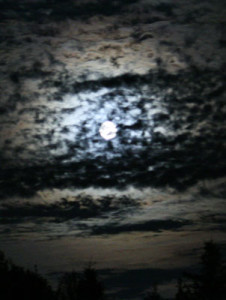The word buttermilk reminds me of two very different things. The first, of course, is the dairy product. I often use buttermilk when I bake but the thought of drinking it as a beverage is repulsive, although I have known lots of old-timers who swore by cornbread and buttermilk as the evening meal. The second meaning that comes to mind is a family memory. The Roy Rogers and Dale Evans Show on television captivated one of my cousins. Kathy always wanted to play cowboys and cowgirls so she could be Dale Evans. She even named her horse Buttermilk after the one Dale Evans rode. Kathy’s horse was buckskin so the name was appropriate.
One evening this summer while I sitting outside with a group of friends under a full moon, someone remarked how pretty the moon was in the Buttermilk Sky. I thought that was the song Hoagy Carmichael crooned in the 1950s or such. But as I looked up I recognized that cloud formation that had remained nameless all my life. Covering the moon, it was gorgeous but also had an eerie feeling.
The next day was a scorcher here. The southwest wind was brutal. That afternoon I saw what looked like thunderheads building up over Sulphur Springs. Ever the optimist I hoped they were heading our way, even though we seldom get rain from the east. Sadly, the thunderheads had dissipated before dark with no rain. I canned Purple Hull Peas that evening and was not particularly interested in the moon. Once the jars were in the canner, I stepped outside to find that the wind had changed from the southwest to a nice northerly breeze. How wonderfully refreshing!
After my canning was done for the evening, I sat down to the computer and googled “buttermilk sky” and “buttermilk sky moon.” The clouds seen the previous night were a buttermilk sky or altocumulus clouds. They are particularly spectacular in the moonlight. Some parts of the world refer to the phenomenon as a “mackerel sky” but since we are not that close to the water, a buttermilk sky it is in Texas.
I also learned that the clouds were the remnants of frontal system. Little, if any rain follows a buttermilk sky. Ironically, there were storm systems north of our nemesis, the high-pressure cap of July and August, the evening before.
I doubt if there were any Buttermilk Skies around here a hundred years ago. According to newspaper reports of July and August 1914, rain was abundant in Northeast Texas. It was so plentiful that farmers began to wonder if the damp weather would increase the likelihood of boll weevils and armyworms. No further mention was made of insects but an even worse tragedy occurred for those in the cotton business.
What began as a “quick war” when Germany planned to march into Paris and defeat the French turned into trench warfare that lasted more than four years. All textile mills in Europe were converted into armament factories. Since U. S. cotton, especially that produced in Northeast Texas, was highly valued in Europe, the war put an end to the exceptional outlet for raw cotton.
Cotton that was so plentiful that fall would sell for less than ten cents a pound. That was if the farmer was able to find a buyer. The loss of the market was devastating to farmers, merchants, bankers, and almost everyone in Northeast Texas. It would take years to recover.

